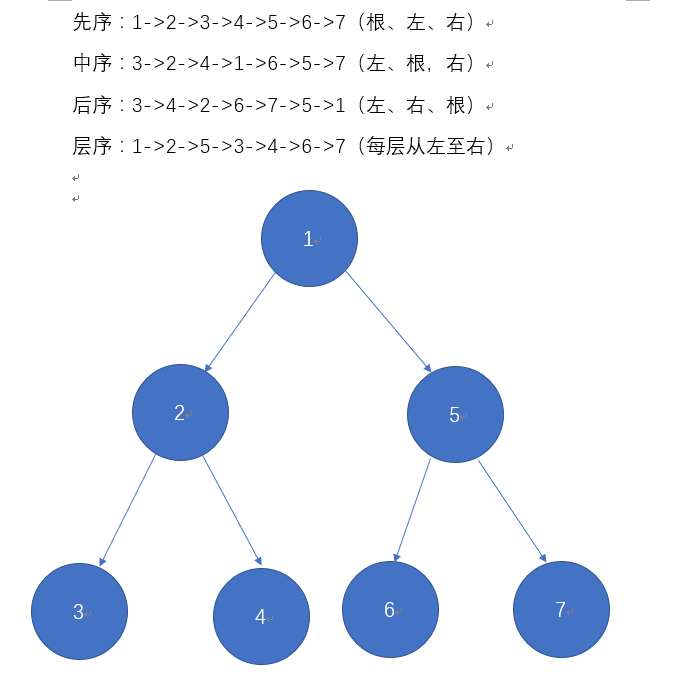//这一行删不了,好气啊,这个编辑器太水了。。。
大家先来看看二叉树的遍历顺序

如果还没理解,这里有一篇不错的博客:看懂二叉树的三种遍历
我们来简单谈谈二叉树:其实二叉树可以用结构体指针来实现,也可以用结构体数组来实现(父节点为tree[k],左儿子为tree[2*k+1], 右儿子为tree[2*k+2])
结构体指针实现二叉树
#include<stdio.h>
#include<iostream>
#include<algorithm>
#include<string.h>
#include<math.h>
#include<stdlib.h>
#include<queue>
#include<map>
#include<set>
#define sa(a) scanf("%d", &a);
#define bug printf("--------");
using namespace std;
typedef long long LL;
const int INF = 1e9;
const int mod = 1e9+7;
int x;
struct node
{
int data;
node *l; //指向左儿子
node *r; //指向右儿子
node() {
l = NULL;
r = NULL;
}
};
//先序法建树(dfs)
void pre_build(node* &T)
{
T = new node;
cin>>x;
if(x != -1) { //我们假设输入-1为结束分支
T->data = x;
pre_build(T->l);
pre_build(T->r);
}else T = NULL;
}
//兄弟(层序)法建树(bfs)
void bre_build(node* &T)
{
queue<node*> q;
T = new node;
cin>>x;
if(x != -1) {
T->data = x;
q.push(T);
}
while(!q.empty()) {
node *p;
p = q.front();
q.pop();
if(p->data != -1) {
cin>>x;
node *L;
L = new node;
if(x != -1) {
L->data = x;
q.push(L);
}else L = NULL;
p->l = L;
cin>>x;
node *R;
R = new node;
if(x != -1) {
R->data = x;
q.push(R);
}else R = NULL;
p->r = R;
}
}
}
//先序遍历(根左右)
void pre_vis(node *T)
{
if(T) {
cout<<T->data<<" ";
pre_vis(T->l);
pre_vis(T->r);
}
}
//中序遍历(左根右)
void mid_vis(node *T)
{
if(T) {
mid_vis(T->l);
cout<<T->data<<" ";
mid_vis(T->r);
}
}
//后序遍历(左右根)
void post_vis(node *T)
{
if(T) {
post_vis(T->l);
post_vis(T->r);
cout<<T->data<<" ";
}
}
//层序遍历(每层从左往右)
void cen_vis(node* &T)
{
queue<node*> q;
q.push(T);
while(!q.empty()) {
node *p;
p = q.front();
q.pop();
if(p) {
cout<<p->data<<" ";
q.push(p->l);
q.push(p->r);
}
}
}
int main()
{
node *T1;
node *T2;
T1 = NULL;
T2 = NULL;
cout<<"先序遍历建树"<<endl;
pre_build(T1);
cout<<"先序遍历:"<<endl;
pre_vis(T1);
cout<<endl<<endl;
cout<<"中序遍历:"<<endl;
mid_vis(T1);
cout<<endl<<endl;
cout<<"后序遍历:"<<endl;
post_vis(T1);
cout<<endl<<endl;
cout<<"层序遍历:"<<endl;
cen_vis(T1);
cout<<endl<<endl;
cout<<"兄弟法建树(类似层序)"<<endl;
bre_build(T2);
cout<<"先序遍历:"<<endl;
pre_vis(T2);
cout<<endl<<endl;
cout<<"中序遍历:"<<endl;
mid_vis(T2);
cout<<endl<<endl;
cout<<"后序遍历:"<<endl;
post_vis(T2);
cout<<endl<<endl;
cout<<"层序遍历:"<<endl;
cen_vis(T2);
cout<<endl<<endl;
return 0;
}
/*
测试数据,大家自己输入运行试试
1 2 3 -1 -1 4 -1 -1 5 6 -1 -1 7 -1 -1
1 2 5 3 4 6 7 -1 -1 -1 -1 -1 -1 -1 -1
*/
结构体数组实现二叉树
#include<stdio.h>
#include<iostream>
#include<algorithm>
#include<string.h>
#include<math.h>
#include<stdlib.h>
#include<queue>
#include<map>
#include<set>
#define sa(a) scanf("%d", &a);
#define bug printf("--------");
using namespace std;
typedef long long LL;
const int INF = 1e9;
const int mod = 1e9+7;
int x;
struct node
{
int val;
}tree[1010*4];
//先序法建树(dfs)
void pre_build(int k) //根节点为1开始
{
cin>>x;
tree[k].val = x;
if(x != -1) { //我们假设输入-1为结束分支
pre_build(2*k+1);
pre_build(2*k+2);
}
}
//兄弟(层序)法建树(bfs)
void bre_build(int k)
{
queue<int> q;
q.push(k);
while(!q.empty()) {
int cur;
cur = q.front();
q.pop();
cin>>x;
tree[cur].val = x;
if(x != -1) {
q.push(2*cur+1);
q.push(2*cur+2);
}
}
}
//先序遍历(根左右)
void pre_vis(int k)
{
if(tree[k].val != -1) {
cout<<tree[k].val<<" ";
pre_vis(2*k+1);
pre_vis(2*k+2);
}
}
//中序遍历(左根右)
void mid_vis(int k)
{
if(tree[k].val != -1) {
mid_vis(2*k+1);
cout<<tree[k].val<<" ";
mid_vis(2*k+2);
}
}
//后序遍历(左右根)
void post_vis(int k)
{
if(tree[k].val != -1) {
post_vis(2*k+1);
post_vis(2*k+2);
cout<<tree[k].val<<" ";
}
}
//层序遍历(每层从左往右)
void cen_vis(int k)
{
queue<int> q;
q.push(k);
while(!q.empty()) {
int cur;
cur = q.front();
q.pop();
if(tree[cur].val != -1) {
cout<<tree[cur].val<<" ";
q.push(2*cur+1);
q.push(2*cur+2);
}
}
}
int main()
{
cout<<"先序遍历建树"<<endl;
pre_build(1);
cout<<"先序遍历:"<<endl;
pre_vis(1);
cout<<endl<<endl;
cout<<"中序遍历:"<<endl;
mid_vis(1);
cout<<endl<<endl;
cout<<"后序遍历:"<<endl;
post_vis(1);
cout<<endl<<endl;
cout<<"层序遍历:"<<endl;
cen_vis(1);
cout<<endl<<endl;
cout<<"兄弟法建树(类似层序)"<<endl;
bre_build(1);
cout<<"先序遍历:"<<endl;
pre_vis(1);
cout<<endl<<endl;
cout<<"中序遍历:"<<endl;
mid_vis(1);
cout<<endl<<endl;
cout<<"后序遍历:"<<endl;
post_vis(1);
cout<<endl<<endl;
cout<<"层序遍历:"<<endl;
cen_vis(1);
cout<<endl<<endl;
return 0;
}
/*
测试数据
1 2 3 -1 -1 4 -1 -1 5 6 -1 -1 7 -1 -1
1 2 5 3 4 6 7 -1 -1 -1 -1 -1 -1 -1 -1
*/